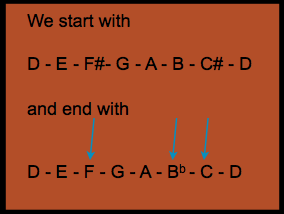"What distinguishes major from minor?" I enjoy posing this question because the common response often involves associating major with 'happy' and minor with 'sad.' This emotional connection to sound is truly remarkable. However, I'd like to simplify it further.
All major scales follow the same pattern. Many are familiar with the Do-Re-Mi-Fa-So-La-Ti-Do sequence, often sung and heard. That's a major scale. Whether you're playing or singing D-Major, B-Major, or F#-Major, they all carry the essence of that iconic Sound of Music melody. Another approach is to observe the notes that are in close proximity. This is more evident on instruments like the violin or piano. In a major scale, the 3rd and 4th notes are close (Mi^Fa), as well as the 7th and 8th notes (Ti^Do). The specific arrangement of neighboring notes defines the major scale pattern.
On the other hand, minor scales follow a distinct pattern, shared among all minor scales. Transitioning to d-minor, for instance, brings the 2nd and 3rd notes together (E^F), along with the 5th and 6th notes (A^Bb)."
All major scales follow the same pattern. Many are familiar with the Do-Re-Mi-Fa-So-La-Ti-Do sequence, often sung and heard. That's a major scale. Whether you're playing or singing D-Major, B-Major, or F#-Major, they all carry the essence of that iconic Sound of Music melody. Another approach is to observe the notes that are in close proximity. This is more evident on instruments like the violin or piano. In a major scale, the 3rd and 4th notes are close (Mi^Fa), as well as the 7th and 8th notes (Ti^Do). The specific arrangement of neighboring notes defines the major scale pattern.
On the other hand, minor scales follow a distinct pattern, shared among all minor scales. Transitioning to d-minor, for instance, brings the 2nd and 3rd notes together (E^F), along with the 5th and 6th notes (A^Bb)."
Now we come to the tricky question of what is minor. There are multiple ways of going about this. The way I was taught in grade school was that you take your major scale, lets say D-Major, and lower the 3rd, 6th, and 7th note.
While this provides a method to distinguish the distinction between a major and minor scale commencing on the same note, it doesn't offer a complete comprehension of the major-minor relationship. This is the juncture where my school lesson ceased, and I would return home, attempting to recollect which notes were lowered and which remained unchanged. However, there exists a notably simpler approach.
We need to delve into what is termed the "relative minor."
Let's commence with a major scale, using D-Major, for continuity. Our key signature encompasses two sharps (F# and C#), and we play the scale as follows:
We need to delve into what is termed the "relative minor."
Let's commence with a major scale, using D-Major, for continuity. Our key signature encompasses two sharps (F# and C#), and we play the scale as follows:
D Major
Let's set aside the concern of locating d-minor for now, and focus on identifying the relative minor. This entails no alteration of any individual note; instead, we will initiate the scale from a different note. To be precise, we'll begin the scale from the 6th note, which is B. Now, let's play the notes present in the D-Major scale, but traversing from B to B
b minor
VOILÀ! We now have a minor scale. B-minor shares the same two sharps as D-Major; they are relatives and, in a sense, represent the same scale. To illustrate, if we were to revert to the Sound of Music, we would encounter the sequence La-Ti-Do-Re-Mi-Fa-So-La. The song might not exude the same lively energy, but the essence is clear.
Indeed, major can evoke happiness while minor can convey a sense of melancholy. Yet, the primary distinction between major and minor lies in their distinct patterns, with minor being a variation of major that commences from a different note.
Indeed, major can evoke happiness while minor can convey a sense of melancholy. Yet, the primary distinction between major and minor lies in their distinct patterns, with minor being a variation of major that commences from a different note.





